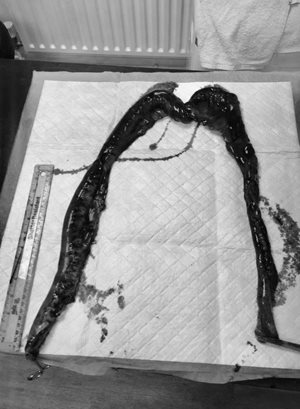Meet Freddie - he’s a 3-year-old Labrador cross. Freddie’s owner brought him to our Hagley practice when he wasn’t feeling well recently. He had been sick, wasn't really eating, and just wasn't feeling himself. Chloé, one our Vets, gave him some medication to help him feel better. When his condition didn’t improve the following day, Freddie’s owners knew something was up.
Chloé took some x-rays and scanned his abdomen. She diagnosed him with an intestinal obstruction, most likely from a foreign body. This meant his guts were blocked and nothing was getting through. This can be life-threatening, so she proceeded to surgery.
The normal surgery for dogs with intestinal obstruction is called an ‘enterotomy’ - which involves cutting into the intestine, removing the offending item, and suturing the wound.
This is a risky, but necessary procedure - if bacteria from the gut get into the abdomen, this can cause severe complications. Vets Chloé and Joao performed the enterotomy successfully, without anything leaking. With this type of procedure, our Vets wait 10-15 minutes after suturing to check the intestines are healthy before closing the abdomen and completing the surgery.
During this time, Chloé and Joao became increasingly concerned that the normally pinky-grey intestines were becoming purple; this means they’re dying. Our team had to act quickly to perform an ‘enterectomy and anastomosis’. This is where the dying or diseased intestines are cut out and the ends sewn together. This is a very risky surgery as the chances of leaking or contamination are much higher than with enterotomy, and any leak could be catastrophic.
At this point, Dominic joined Chloé and Joao, and all three Vets were scrubbed in. Our Veterinary Nurses were all on hand monitoring Freddie, and keeping him alive with fluids, antibiotics, pain relief, and anaesthetics. All in all, over 100cm of his intestine was removed and the two ends were sutured shut. After our team were happy that the sutures would hold, they closed the abdomen, and woke Freddie up from his anaesthetic.

Despite being pleased with the outcome so far, he was not out of the woods. Survival rates vary but sadly, up to 1 in 6 dogs do not make it to discharge.
Following surgery, Freddie was hospitalised for 3 days on fluids, pain relief, pro-kinetics, and anti-nausea medications (to encourage him to eat), and lots of TLC from our Nurses.
Little-by-little, over the next 5-6 days, Freddie became more and more himself, and his appetite started to return. Every time our team saw him, he was scanned for fluid (a sign of leakage) and for peristalsis (gut movement).
The exact foreign body is unknown but our (and Freddie’s owners) best guess is that it was gristle from some meat he ate a few days prior.
After 2 weeks, Freddie was signed off with strict instructions to avoid butchers!
Everyone is delighted with his recovery. It was thanks to his owner’s diligence, and the knowledge, time, and skill of all the Clent Hills staff involved with his care, that Freddie’s story had a happy ending.
Meet our team